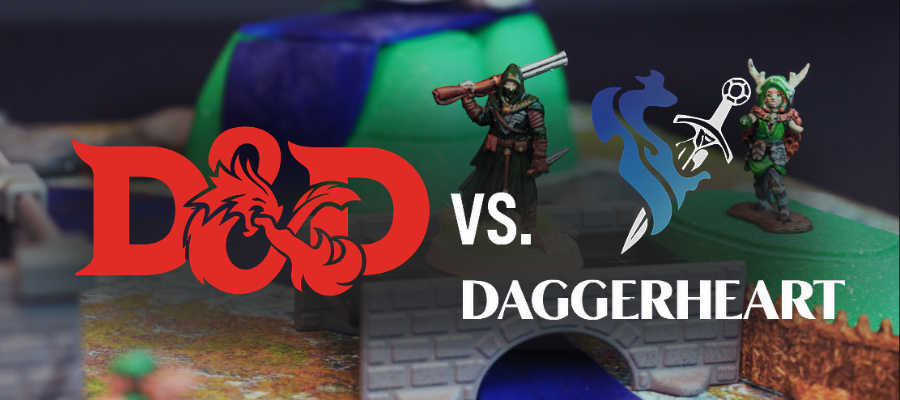
Beyond the Dungeon: Dungeons & Dragons vs. Daggerheart TTRPG
Share
Beyond the Dungeon: Dungeons & Dragons vs. Daggerheart TTRPG
With the recent shifts in the TTRPG landscape, there is a new rising star on the horizon for players. For decades, Dungeons & Dragons has been the undisputed titan of tabletop RPGs, introducing countless players to the joys of collaborative storytelling and epic fantasy adventures. But a new challenger has emerged from the creative minds behind Critical Role: Daggerheart. While both games immerse you in fantastic worlds, they offer distinctly different experiences. So, if you're wondering which might be your next obsession, let's break down the key differences. Whether you're exploring the classic dungeons of D&D or venturing into the uncharted territories of Daggerheart, having the right setup can truly enhance the experience, bringing the fantastical worlds to life right at your table.
The Core Dice Mechanic: D20 vs. Hope & Fear
At the heart of any TTRPG is its dice rolling system, and here D&D and Daggerheart diverge significantly.
-
Dungeons & Dragons: The iconic d20 reigns supreme. When you attempt an action with an uncertain outcome – attacking a goblin, picking a lock, charming a guard – you roll a single twenty-sided die, add any relevant modifiers, and compare the total to a target number set by the Dungeon Master (DM). It's a straightforward "succeed or fail" system, with critical successes and failures (natural 20s and 1s) adding moments of dramatic swing.
-
Daggerheart: Daggerheart introduces the intriguing Duality Dice system, where you roll two 12-sided dice: one representing Hope and the other Fear. You still take the higher result for determining success, but the magic happens based on which die is higher. If the Hope die is higher, the player gains a Hope point, a valuable resource they can spend on powerful abilities or to influence the narrative. If the Fear die is higher, the GM gains a Fear point, which they can then spend to introduce complications, activate monster abilities, or escalate the stakes. This system injects a constant push-and-pull into every action, tying mechanical success directly to narrative consequences.
Combat Flow: Initiative vs. Collaborative Momentum
Combat in D&D is often a tactical dance, while Daggerheart prioritizes a more fluid, narrative-driven approach.
-
Dungeons & Dragons: Combat in D&D is structured around initiative, a turn order determined at the start of an encounter. Players and monsters act in sequence, moving, attacking, and using abilities within defined rounds. This can lead to strategic positioning and thoughtful use of actions, but can sometimes feel a bit like a board game.
-
Daggerheart: Say goodbye to initiative! Daggerheart's combat is free-flowing and collaborative. Players largely decide among themselves who acts when, creating a more organic and cinematic feel. The GM doesn't have a fixed turn; instead, they take actions when Fear builds up (from player rolls where the Fear die was higher) or when narrative opportunities arise. This keeps the action moving and encourages players to think creatively about how their characters work together in the moment.
Character Progression & Customization
Both games offer robust character creation, but their progression paths have different flavors.
-
Dungeons & Dragons: Character progression in D&D is largely tied to levels, where characters gain pre-determined features, spells, and ability score increases as they accrue experience points or reach narrative milestones. While subclasses and feats offer some customization, two characters of the same class and subclass will often feel mechanically similar, particularly at lower levels.
-
Daggerheart: Daggerheart emphasizes a high degree of player agency and customization. While it also uses a level system (capped at 10, compared to D&D's 20), characters are built with a combination of Ancestry, Community, Class, Subclass, and two distinct Domains which dictate their abilities. Players choose abilities from these Domains as they progress, leading to a much wider array of unique character builds. The use of ability cards also provides a tangible and visual representation of a character's powers. Daggerheart also introduces "Experiences," freeform background qualities that can grant bonuses to relevant rolls, further individualizing characters.
Narrative Focus and GM Control
The underlying philosophy of storytelling differs between the two.
-
Dungeons & Dragons: D&D, especially in its 5th edition, aims for a balance of combat, exploration, and social interaction. While roleplaying is encouraged, the rules often provide more structure for combat and exploration, leaving social encounters more to GM adjudication. The DM generally has a high degree of control over the world and narrative, presenting challenges for the players to overcome.
-
Daggerheart: Daggerheart explicitly brands itself as a narrative-first, heroic fantasy TTRPG. It emphasizes collaborative worldbuilding, with the GM frequently asking players questions about the world and their characters' backstories to weave into the ongoing story. The Hope and Fear dice, as mentioned, constantly push the narrative forward, ensuring that every roll has a tangible impact on the story's direction. It's designed to facilitate cinematic, player-driven stories, even in combat.
Which Game is Right for You?
Ultimately, the "better" game depends on your table's preferences:
-
Choose Dungeons & Dragons if:
-
You enjoy tactical combat and clear turn-based structure.
-
You prefer a more established system with a vast library of content, modules, and a strong existing community.
-
You like the satisfaction of building a character through a familiar progression system.
-
Choose Daggerheart if:
-
You crave a more fluid, narrative-driven experience where every roll impacts the story.
-
You enjoy collaborative worldbuilding and a greater degree of player agency in shaping the game.
-
You're looking for a fresh take on fantasy TTRPG mechanics, especially in combat.
-
You appreciate a system designed with streamlined, cinematic play in mind.
Both Dungeons & Dragons and Daggerheart offer incredible opportunities for adventure and storytelling. D&D is the tried-and-true classic, while Daggerheart offers an innovative and narrative-focused alternative. Perhaps the best approach is to try both and see which one truly captures your table's imagination!
